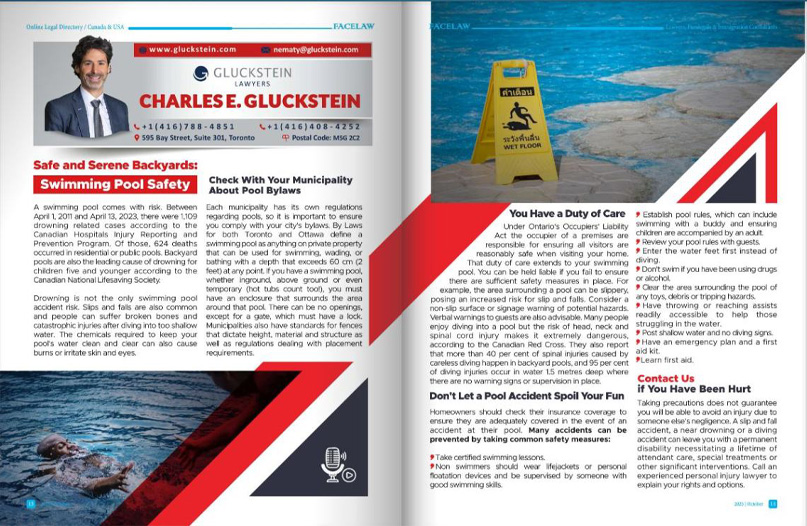Safe and Serene Backyards: Swimming Pool Safety
Safe and Serene Backyards: Swimming Pool Safety
A swimming pool comes with risk. Between April 1, 2011 and April 13, 2023, there were 1,109 drowning-related cases according to the Canadian Hospitals Injury Reporting and Prevention Program. Of those, 624 deaths occurred in residential or public pools.
Backyard pools are also the leading cause of drowning for children five and younger according to the Canadian National Lifesaving Society.
Drowning is not the only swimming pool accident risk. Slips and falls are also common and people can suffer broken bones and catastrophic injuries after diving into too-shallow water. The chemicals required to keep your pool's water clean and clear can also cause burns or irritate skin and eyes.
Check With Your Municipality About Pool Bylaws.
Each municipality has its own regulations regarding pools, so it is important to ensure you comply with your city's bylaws.
By-Laws for both Toronto and Ottawa define a swimming pool as anything on private property that can be used for swimming, wading, or bathing with a depth that exceeds 60 cm (2 feet) at any point.
If you have a swimming pool, whether inground, above ground or even temporary (hot tubs count too!), you must have an enclosure that surrounds the area around that pool. There can be no openings, except for a gate, which must have a lock.
Municipalities also have standards for fences that dictate height, material and structure as well as regulations dealing with placement requirements.
You Have a Duty of Care.
Under Ontario's Occupiers' Liability Act the occupier of a premises are responsible for ensuring all visitors are reasonably safe when visiting your home.
That duty of care extends to your swimming pool. You can be held liable if you fail to ensure there are sufficient safety measures in place. For example, the area surrounding a pool can be slippery, posing an increased risk for slip and falls. Consider a non-slip surface or signage warning of potential hazards. Verbal warnings to guests are also advisable.
Many people enjoy diving into a pool but the risk of head, neck and spinal cord injury makes it extremely dangerous, according to the Canadian Red Cross. They also report that more than 40 per cent of spinal injuries caused by careless diving happen in backyard pools, and 95 per cent of diving injuries occur in water 1.5 metres deep where there are no warning signs or supervision in place.
Don't Let a Pool Accident Spoil Your Fun.
Homeowners should check their insurance coverage to ensure they are adequately covered in the event of an accident at their pool.
Many accidents can be prevented by taking common safety measures:
-
Take certified swimming lessons.
-
Non-swimmers should wear lifejackets or personal floatation devices and be supervised by someone with good swimming skills.
-
Establish pool rules, which can include swimming with a buddy and ensuring children are accompanied by an adult.
-
Review your pool rules with guests.
-
Enter the water feet-first instead of diving.
-
Don't swim if you have been using drugs or alcohol.
-
Clear the area surrounding the pool of any toys, debris or tripping hazards.
-
Have throwing or reaching assists readily accessible to help those struggling in the water.
-
Post shallow water and no diving signs.
-
Have an emergency plan and a first aid kit.
-
Learn first aid.
Contact Us if You Have Been Hurt.
Taking precautions does not guarantee you will be able to avoid an injury due to someone else's negligence. A slip and fall accident, a near drowning or a diving accident can leave you with a permanent disability necessitating a lifetime of attendant care, special treatments or other significant interventions.
Call an experienced personal injury lawyer to explain your rights and options.





